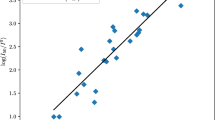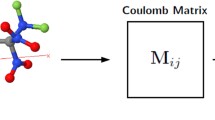Abstract
In the present work, four machine learning algorithms back propagation neural network, multilayer perceptron, random forest and support vector regression were employed to predict both the impact sensitivity and electrostatic spark sensitivity of energetic compounds. Based on the density functional theory calculations mainly, there are nine and ten different kinds of descriptors which contain the important parameters related to the molecular composition and structure, the electronic structure, the structural stability and strength, and the energy performance have been selected out to construct the ML models for predicting the impact sensitivity and electrostatic spark sensitivity, respectively. It could be found that selected descriptors are well correlated with the experimental results which have high Pearson’s correlation coefficients generally. For the impact sensitivity, the oxygen balance, charge of nitro group, heat of release and self-multiplying coefficient are key descriptors which should be with larger weightiness in the construction of the ML model, while those are the detonation velocity and detonation pressure in the ML of electrostatic spark sensitivity. Based on the analysis and comparing of various parameters for the assessment of ML models, for both the impact sensitivity and electrostatic spark sensitivity, the back propagation neural network model was found to be possess high accuracy and better than other three used models. This work may provide new methods for predicting the sensitivity of energetic compounds and promote the application of machine learning in the field of energetic compounds.
Graphical abstract
















Similar content being viewed by others
References
Xu Y, Wang Q, Shen Q, Lin Q, Wang P, Lu M (2017) A series of energetic metal pentazolate hydrates. Nature 549:78–81
Zhang C, Sun C, Hu B, Yu C, Lu M (2017) Synthesis and characterization of the pentazolate anion cyclo-N5- in (N5)6(H3O)3(NH4)4Cl. Science 355:374–376
Lai Q, Pei L, Fei T, Yin P, Pang S, Shreeve JM (2022) Size-matched hydrogen bonded hydroxylammonium frameworks for regulation of energetic materials. Nat Commun 13:6937
Yount J, Piercey DG (2022) Electrochemical synthesis of high-nitrogen materials and energetic materials. Chem Soc Rev 122:8809–8840
Kang Y, Dong Y, Liu Y, Gao H, Wang Y, Shreeve JM (2022) Halogen bonding (C-F···X) and its effect on creating ideal insensitive energetic materials. Chem Eng J 440:135969
Wang J, Liu D, Zhang J, Gong F, Zhao X, Yang Z (2024) Design of conductive polymer coating layer for effective desensitization of energetic materials. Chem Eng J 482:148874
Lv RB, Jiang L, Wang JX, Huang SL, Song SW et al (2024) A zwitterionic fused-ring framework as a new platform for heat-resistant energetic materials. J Mater Chem A. https://doi.org/10.1039/d4ta00184b
Rajak R, Kumar N, Ghule VD, Dharavath S (2024) Highly dense N-N-bridged dinitramino bistriazole-based 3D metal-organic frameworks with balanced outstanding energetic performance. ACS Appl Mater. https://doi.org/10.1021/acsami.4c04026
Lu H, Diaz DJ, Czarnecki NJ (2022) Machine learning-aided engineering of hydrolases for PET depolymerization. Nature 604:662–667
Rao ZY, Tung PY, Xie RW (2022) Machine learning-enabled high-entropy alloy discovery. Science 378:78–85
Mortazavi B, Javvaji B, Shojaei F, Rabczuk T, Shapeev AV, Zhuang X (2021) Exceptional piezoelectricity, high thermal conductivity and stiffness and promising photocatalysis in two-dimensional MoSi2N4 family confirmed by first-principles. Nano Energy 82:105716
Yang C, Chen J, Wang R, Zhang M, Zhang C, Liu J (2021) Density prediction models for energetic compounds merely using molecular topology. J Chem Inf Model 61(6):2582–2593
Jin JX, Ren GP, Hu J, Liu Y, Gao Y, Wu KJ, He Y (2023) Force field-inspired transformer network assisted crystal density prediction for energetic materials. J Cheminform 15:65
Gou Q, Liu J, Su H, Guo Y, Chen J, Zhao X, Pu X (2024) Exploring an accurate machine learning model to quickly estimate stability of diverse energetic materials. iScience 27:109452
Wu JN, Song SW, Tian XL, Wang Y, Qi XJ (2023) Machine learning-based prediction and interpretation of decomposition temperatures of energetic materials. Energ Mater Front 4:254–261
Song S, Wang Y, Chen F, Yan M, Zhang Q (2022) Machine learning-assisted high-throughput virtual screening for on-demand customization of advanced energetic materials. Engineering 10:99–109
Jiang Y, Yang Z, Guo J, Li H, Liu Y, Guo Y, Li M, Pu X (2021) Coupling complementary strategy to flexible graph neural network for quick discovery of coformer in diverse co-crystal materials. Nat Commun 12(1):5950
Sami Y, Richard N, Gauchard D, Estève A, Rossi C (2022) Selecting machine learning models to support the design of Al/CuO nanothermites. J Phys Chem A 126(7):1245–1254
Wespiser C, Mathieu D (2023) Application of machine learning to the design of energetic materials: preliminary experience and comparison with alternative techniques. Propellants Explos Pyrotech 48(4):e202200264
Storm CB, Stine JR, Kramer JF (1990) Sensitivity relationships in energetic materials. In: Bulusu SN (ed) Chemistry and physics of energetic materials. Springer, Dordrecht, pp 605–639
Zhang H, Cheung F, Zhao F, Cheng XL (2009) Band gaps and the possible effect on impact sensitivity for some nitro aromatic explosive materials. Int J Quantum Chem 109(7):1547–1552
Zhang CY, Shu YJ, Huang YG, Wang XF (2005) Theoretical investigation of the relationship between impact sensitivity and the charges of the nitro group in nitro compounds. J Energ Mater 23(2):107–119
Bao G, Abe RY, Bond AY (2021) Bond dissociation energy and thermal stability of energetic materials. J Therm Anal Calorim 143(5):3439–3445
Song X, Cheng X, Yang X, Li D, Linghu R (2008) Correlation between the bond dissociation energies and impact sensitivities in nitramine and polynitro benzoate molecules with polynitro alkyl groupings. J Hazard Mater 150(2):317–321
DrEmin A (2008) On the mechanism of molecular condensed EMs transformation under the effect of shock and detonation waves. J Energ Mater 5:31–44
Campbell AW, Davis WC, Travis JR (1961) Shock initiation of detonation in liquid explosives. Phys Fluids 4(4):498–510
Bauer B, Bravyi S, Motta M, Chan GKL (2020) Quantum algorithms for quantum chemistry and quantum materials science. Chem Soc Rev 120(22):12685–12717
Wang R, Liu J, He X, Xie W, Zhang C (2022) Decoding hexanitrobenzene (HNB) and 1,3,5-triamino-2,4,6-trinitrobenzene (TATB) as two distinctive energetic nitrobenzene compounds by machine learning. Phys Chem Chem Phys 24(17):9875–9884
Larin AA, Shaferov AV, Kulikov AS et al (2021) Design and synthesis of nitrogen-rich Azo-bridged furoxanylazoles as high-performance energetic materials. Chem Eur J 27(59):14628–14637
Alpaslan YB, Alpaslan G, Ağar AA, İskeleli NO, Öztekin E (2011) Experimental and density functional theory studies on (E)-2-[(2-(hydroxymethyl)phenylimino)methyl]benzene-1,4-diol. J Mol Struct 995(1):58–65
He P, Zhang JG, Wang K, Yin X, Zhang TL (2016) Computational studies on two novel energetic nitrogen-rich compounds based on tetrazolone. J Phys Org Chem 29(1):29–34
Xu XJ, Xiao HM, Ju XH, Gong XD, Zhu WH (2016) Computational studies on polynitrohexaazaadmantanes as potential high energy density materials. J Phys Chem A 110(17):5929–5933
Frisch MJ, Trucks GW, Schlegel HB, Scuseria GE, Robb MA, Cheeseman JR (2009) Gaussian09, Revision A.02., Wallingford CT
Xiong XX (2020) Research on the method of impact sensitivity prediction methods of energetic materials based on molecules and crystals. Southwest University of Science and Technology, Mianyang
Ferdowsi M, Yazdani F, Omidkhah MR, Keshavarz MH (2018) A general relationship between electric spark and impact sensitivities of nitroaromatics and nitramines. Z Anorg Allg Chem 644(23):1623–1628
Svatopluk Z, Jirí KOC (2000) Electric spark sensitivity of polynitro compounds: part IV. A relation to thermal decomposition parameters. Chin J Energ Mater 8(1):18–26
Murray JS, Lane P, Politzer P, Bolduc PR (1990) A relationship between impact sensitivity and the electrostatic potentials at the midpoints of C NO2 bonds in nitroaromatics. Chem Phys Lett 168(2):135–139
Keshavarz MH, PouretedalSemnani HR (2007) A Novel correlation for predicting impact sensitivity of nitroheterocyclic energetic molecules. J Hazard Mater 141(3):803–807
Bellitto VJ, Melnik MI (2010) Surface defects and their role in the shock sensitivity of cyclotrimethylene-trinitramine. Appl Surf Sci 256(11):3478–3481
Li G, Zhang C (2020) Review of the molecular and crystal correlations on sensitivities of energetic materials. J Hazard Mater 398:122910
Liu WH, Liu QJ, Zhong M, Gan YD, Liu FS, Li XH, Tang B (2022) Predicting impact sensitivity of energetic materials: insights from energy transfer of carriers. Acta Mater 236:118137
Chen S, Li L, Song S, Zhang Q (2023) Regulating the thermal stability and energy of fused-ring energetic materials by hydrazo bridging and hydrogen-bonding networks. Cryst Growth Des 23(7):4970–4978
Meng J, Fei T, Cai J et al (2023) Backbone isomerization to enhance thermal stability and decrease mechanical sensitivities of 10 nitro-substituted bipyrazoles. ACS Appl Mater Interfaces 15(41):48346–48353
Zhu W, Xiao H (2010) First-principles band gap criterion for impact sensitivity of energetic crystals: a review. Struct Chem 21(3):657–665
Yadav AK, Ghule VD, Dharavath S (2022) Dharavath, Facile fabrication of functionalized pyrimidine derivatives: constructing a new family of high performance and less sensitive energetic compounds. J Mater Chem A 10(23):12702–12712
Hou TY, Xu Z, Zhang XP, Xu YG, Lu M (2022) High-density and low-sensitivity energetic materials based on conjugated fused rings. Energ Mater Front 3(3):166–171
Yan T, Yang C, Ma J, Cheng G, Yang H (2022) Intramolecular integration of multiple heterocyclic skeletons for energetic materials with enhanced energy & safety. Chem Eng J 428:131400
Gramatica P (2007) Principles of QSAR models validation: internal and external. QSAR Comb Sci 26(5):694–701
Zhi C, Cheng X (2010) The correlation between electric spark sensitivity of polynitroaromatic compounds and their molecular electronic properties. Propellants Explos Pyrotech 35(6):555–560
Tang C, Chen X, Wang J, Hu Y (2013) Relationship betweenelectric spark sensitivity of some nitramines and their electronic properties in external electric field. J Sichuan Univ Nat Sci Ed 50(2):321–325
Simpson RL, Urtiew PA, Ornellas DL, Moody GL, Scribner KJ, Hoffman DM (1997) CL-20 performance exceeds that of HMX and its sensitivity is moderate. Propellants Explos Pyrotech 22(5):249–255
Eaton PE, Gilardi RL, Zhang MX (2000) Polynitrocubanes: Advanced high-density, high-energy materials. Adv Mater 12(15):1143–1148
Zhang G, Yi Z, Cheng G, Yang W, Yang H (2022) Polynitro-functionalized azopyrazole with high performance and low sensitivity as novel energetic materials. ACS Appl Mater Interfaces 14(8):10594–10604
Acknowledgements
The present work was supported by the National Natural Science Foundation of China (51802156), Natural Science Foundation of Jiangsu (BK20170761, BK20181302), Postdoctoral Research Funding Program of Jiangsu (2021K192B), and Outstanding Scientific and Technological Innovation Team in Colleges and Universities of Jiangsu Province. Extra-curricular Academic Scientific Research Fund of Nanjing University of Science and Technology and Undergraduate Research Training Millions Talents’ Plan (2023).
Author information
Authors and Affiliations
Corresponding authors
Ethics declarations
Conflict of interest
The authors declare that they have no known competing financial interests or personal relationships that could have appeared to influence the work reported in this paper.
Additional information
Handling Editor: Ghanshyam Pilania.
Publisher's Note
Springer Nature remains neutral with regard to jurisdictional claims in published maps and institutional affiliations.
Supplementary Information
Below is the link to the electronic supplementary material.
Rights and permissions
Springer Nature or its licensor (e.g. a society or other partner) holds exclusive rights to this article under a publishing agreement with the author(s) or other rightsholder(s); author self-archiving of the accepted manuscript version of this article is solely governed by the terms of such publishing agreement and applicable law.
About this article
Cite this article
Wu, Q., Wang, X., Yan, B. et al. Prediction of impact sensitivity and electrostatic spark sensitivity for energetic compounds by machine learning and density functional theory. J Mater Sci (2024). https://doi.org/10.1007/s10853-024-09742-x
Received:
Accepted:
Published:
DOI: https://doi.org/10.1007/s10853-024-09742-x




